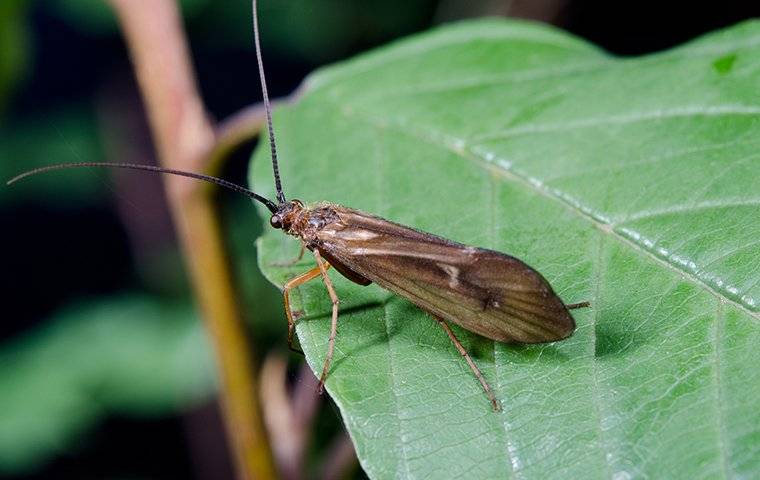
Caddis Fly
Description
The caddis fly varies in size from 1/16 inch to 1 inch in length, depending on the species, and its color ranges from brown to black. Caddisflies are slender, elongated insects with furry, almost moth-like wings that they hold tent-like on the abdomen. They have long antennae, wire type, attached to their heads.
Caddisflies in High Point are important insects in freshwater ecosystems, where they reproduce in streams, ponds, and lakes, serving as food for a wide variety of aquatic animals, especially fish. Adults of a particular species emerge from the water at about the same time, sometimes forming clouds of insects over the water. These adults are strongly attracted to lights on buildings located near waterways, thus becoming “plagues” at times.

Most commonly, one or two adult caddis flies will accidentally fly into a home where the owner might become worried. Grown-ups live for around one month and feast upon nectar consumed by basic mouthparts. Female caddis flies lay masses of eggs on vegetation over the water’s surface. When the hatchlings are shown in the eggs, they fall into the water and quickly begin to assemble defensive cases.
At the point when the hatching is completely developed, it enters the pupal stage. The hatching appends the case to some strong protest, as like stone or a bigger bit of submerged wood, and seals the opening. In this way makes the casing of silk around the body. Pupal cases can be punctured and in this manner water porous. In addition, creepy crawlies experiencing change inside the case undulated, with a specific end goal to make a stream of oxygenated water around the body.
Combine of sectioned legs reaches out from each thoracic portion. Legs can have adjustments like sharp endings, snares, or columns of setae. Their motivation is to help the hatchlings in development, fabricating the sanctuary, or gathering nourishment. They are utilized to grapple the hatchlings for the situation. Their eyes are little and straightforward. Receiving wires are little and can be seen just under high magnification.
Constantly submerged stones and bits of wood give the best substrate to the development of green growth and periphyton, which the hatchlings successfully scrap. As they brush, caddis fly hatchlings may expend a noteworthy part of the accessible green growth in the stream. A few animal groups with extensive mouth parts shred leaves of earthbound plants fallen into the water.
Caddis fly hatchlings acquire oxygen which is broken up in water through thin and delicate skin. A few animal groups have spread gills or protuberances on the sides of the body (with a specific end goal to build the body surface). Hatchlings undulate their bodies to make a stream of oxygenated water through the case.
Caddis fly larvae are common denizens along the banks of rivers, streams, and lakes. Larvae of many species build protective cases over their bodies using bits of sand, branches and other debris. These cases are sometimes quite intricate and serve to camouflage the larvae of potential predators. Caddis flies are an important insect for the flying fisherman who will use many variations of artificial flies to mimic caddis fly larvae which leads adults to effectively attract and catch trout.
How To Prevent/Control
Caddis flies cannot be controlled through treatments because they reproduce in aquatic environments and only become pests when attracted by outdoor lights to buildings. However, any emergence of caddis flies should only last for a few days. Where these insects are being a problem, the exterior light fixtures should be turned off or have yellow “bubbles error” lamps installed. Commercial buildings need to use sodium vapor lamps in luminaries instead of mercury vapor lamps.
Customer Reviews
-
“He spent time educating us about "pests" and provided information regarding services with GoForth.”- Joyce C.
-
“Texted me before coming. Worked with me playing musical rooms with my dogs. I'll see how things are.”- Constance E.
-
“Amazing response time, reasonable prices, great customer service. Tevin was thorough and confident in his plan to fix our horrendous fire ant problem. We have had negative experiences with prior exterminators and probably waited way too long to call Go-For”- Ashley T.
-
“- Toya B.
We have been customers for almost 7 years for a reason. Our technician is the best. He always knows exactly how to address whatever pest has decided to bother us. We have referred them to many of our neighbors. Well worth the cost not to have to worry a
” -
“Answered all my questions and I felt their pricing was very reasonable.”- Deborah J.
-
“Brian went above and beyond what was expected, and I hope I get him again as my technician for future services!”- Tam L.
-
“He was thorough with inspecting and treating our home, which I really appreciate, and he took the time to answer my many questions.”- Jasmine B.
-
“Love the detailed summary and pics of what he did and saw! And did I mention how wonderful Olivia was to get us all set up?!!”- Beechy A.


Why Choose Go-Forth Home Services?
-
The Best & Highest ReviewsBBB A+ Rated and 4.8 or higher on Google and Facebook for the highest rated local company in the Triad.
-
Seven North Carolina Technicians of the YearHome of the 2009, 2010, 2012, 2013, 2014, 2015, & 2016 statewide technicians of the year.
-
A+ Rating with Better Business BureauBBB Accredited since 1973 for 48 years of continuous accreditation.
-
Serving North Carolina, South Carolina, Georgia, & Virginia
With six locations and dozens of technicians in the field every day, we service areas of North & South Carolina, Georgia, and Virginia.
-
Residential & Commercial ServiceResidential and commercial clients in Greensboro, NC and beyond can attest - Go-Forth provides only the very best in home services.
-
4.9 Star Google Review Rating Across Three StatesGo-Forth Home Services is proud to have thousands of Google reviews with an average rating of 4.9 stars!